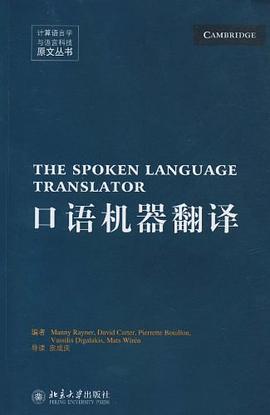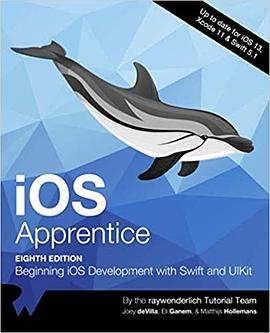

具体描述
《口语机器翻译》主要内容简介:计算语言学研究滥觞于上世纪五六十年代的机器翻译研究。中文的相关研究也几乎同步开始,1960年起在柏克莱加州大学研究室,王士元、邹嘉彦、C.Y.Dougherty等人已开始研究中英、中俄机器翻译。他们的中文计算语言学研究,可说是与世界最尖端科技同步的。
作者简介
目录信息
导读
Preface
Acknowledgements
Introduction
1.1 What This Book Is About
1.1.1 Why Do Spoken Language Translation?
1.1.2 What Are the Basic Problems?
1.1.3 What Is It Realistic to Attempt Today?
1.1.4 What Have We Achieved?
1.2 Overall System Architecture
1.3 An Illustrative Example
1.4 In Defence of Hand-Coded Grammars
1.5 Hybrid Transfer
1.5.1 The Need for Grammatical Knowledge
1.5.2 The Need for Preferences
1.6 Speech Processing
1.7 Corpora
Part 1 Language Processing and Corpora
Translation Using the Core Language Engine
2.1 Introduction: Multi-Engine Translation
2.2 Word-to-Word Translation
2.3 Quasi Logical Form
2.3.1 Introduction
2.3.2 Structure of QLF
2.3.3 QLF as a Transfer Formalism: Examples
2.3.4 Head-Head Relations in QLF
2.4 Unification Grammar and QLFs
2.4.1 The CLE Unification Grammar Formalism
2.4.2 Unification Grammar Example: French Noun Phrases
2.4.3 Example 2a: Clauses in Swedish
2.4.4 Example 2b: Relative Clauses in Swedish
2.5 Orthographic Analysis and the Lexicon
2.6 Transfer Rules
2.6.1 Pre- and Posttransfer
2.7 The QLF-Based Processing Path
2.7.1 Linguistic Analysis
2.7.2 Transfer and Transfer Preferences
2.7.3 Generation
2.8 Summary
Grammar Specialisation
3.1 Introduction
3.2 Explanation-Based Learning for Grammar
Specialisation
3.2.1 A Definition of Explanation-Based Learning
3.2.2 Explanation-Based Learning on Unification Grammars
3.2.3 Category Specialisation
3.2.4 Elaborate Cutting-Up Criteria
3.3 An LR Parsing Method for Specialised Grammars
3.3.1 Basic LR Parsing
3.3.2 Prefix Merging
3.3.3 Abstraction
3.4 Empirical Results
3.4.1 Experimental Setup
3.4.2 Discussion of Results
3.5 Conclusions
Choosing among Interpretations
4.1 Properties and Discriminants
4.2 Constituent Pruning
4.2.1 Discriminants for Pruning
4.2.2 Deciding Which Edges to Prune
4.2.3 Probability Estimates for Discriminants
4.2.4 Relation to Other Pruning Methods
4.3 Choosing among QLF Analyses
4.3.1 Analysis Choice: An Example
4.3.2 Further Advantages of a Discriminant Scheme .
4.3.3 Numerical Metrics
4.4 Choosing among Transferred QLFs
4.5 Choosing Paths in the Chart
The TreeBanker
5.1 Motivation
5.2 Representational Issues
5.3 Overview of the TreeBanker
5.4 The Supervised Training Process
5.4.1 Properties and Discriminants in Training
5.4.2 Additional Functionality
5.5 Training for Transfer Choice
5.6 Evaluation and Conclusions
Acquisition of Lexical Entries
6. 1 The Lexical Acquisition Tool, LexMake
6.2 Acquiring Word-to-Word Transfer Rules
6.3 Evaluation and Conclusions
Spelling and Morphology
7.1 Introduction
7.2 The Description Language
7.2.1 Morphophonology
7.2.2 Word Formation and Interfacing to Syntax
7.3 Compilation
7.3.1 Compiling Spelling Patterns
7.3.2 Representing Lexical Roots
7.3.3 Applying Obligatory Rules
7.3.4 Interword Rules
7.3.5 Timings
7.4 Some Examples
7.4.1 Multiple-Letter Spelling Changes
7.4.2 Using Features to Control Rule Application
7.4.3 Interword Spelling Changes
7.5 Debugging the Rules
……
Part 2 Linguistic Coverage
Part 3 Speech Processing
· · · · · · (收起)
Preface
Acknowledgements
Introduction
1.1 What This Book Is About
1.1.1 Why Do Spoken Language Translation?
1.1.2 What Are the Basic Problems?
1.1.3 What Is It Realistic to Attempt Today?
1.1.4 What Have We Achieved?
1.2 Overall System Architecture
1.3 An Illustrative Example
1.4 In Defence of Hand-Coded Grammars
1.5 Hybrid Transfer
1.5.1 The Need for Grammatical Knowledge
1.5.2 The Need for Preferences
1.6 Speech Processing
1.7 Corpora
Part 1 Language Processing and Corpora
Translation Using the Core Language Engine
2.1 Introduction: Multi-Engine Translation
2.2 Word-to-Word Translation
2.3 Quasi Logical Form
2.3.1 Introduction
2.3.2 Structure of QLF
2.3.3 QLF as a Transfer Formalism: Examples
2.3.4 Head-Head Relations in QLF
2.4 Unification Grammar and QLFs
2.4.1 The CLE Unification Grammar Formalism
2.4.2 Unification Grammar Example: French Noun Phrases
2.4.3 Example 2a: Clauses in Swedish
2.4.4 Example 2b: Relative Clauses in Swedish
2.5 Orthographic Analysis and the Lexicon
2.6 Transfer Rules
2.6.1 Pre- and Posttransfer
2.7 The QLF-Based Processing Path
2.7.1 Linguistic Analysis
2.7.2 Transfer and Transfer Preferences
2.7.3 Generation
2.8 Summary
Grammar Specialisation
3.1 Introduction
3.2 Explanation-Based Learning for Grammar
Specialisation
3.2.1 A Definition of Explanation-Based Learning
3.2.2 Explanation-Based Learning on Unification Grammars
3.2.3 Category Specialisation
3.2.4 Elaborate Cutting-Up Criteria
3.3 An LR Parsing Method for Specialised Grammars
3.3.1 Basic LR Parsing
3.3.2 Prefix Merging
3.3.3 Abstraction
3.4 Empirical Results
3.4.1 Experimental Setup
3.4.2 Discussion of Results
3.5 Conclusions
Choosing among Interpretations
4.1 Properties and Discriminants
4.2 Constituent Pruning
4.2.1 Discriminants for Pruning
4.2.2 Deciding Which Edges to Prune
4.2.3 Probability Estimates for Discriminants
4.2.4 Relation to Other Pruning Methods
4.3 Choosing among QLF Analyses
4.3.1 Analysis Choice: An Example
4.3.2 Further Advantages of a Discriminant Scheme .
4.3.3 Numerical Metrics
4.4 Choosing among Transferred QLFs
4.5 Choosing Paths in the Chart
The TreeBanker
5.1 Motivation
5.2 Representational Issues
5.3 Overview of the TreeBanker
5.4 The Supervised Training Process
5.4.1 Properties and Discriminants in Training
5.4.2 Additional Functionality
5.5 Training for Transfer Choice
5.6 Evaluation and Conclusions
Acquisition of Lexical Entries
6. 1 The Lexical Acquisition Tool, LexMake
6.2 Acquiring Word-to-Word Transfer Rules
6.3 Evaluation and Conclusions
Spelling and Morphology
7.1 Introduction
7.2 The Description Language
7.2.1 Morphophonology
7.2.2 Word Formation and Interfacing to Syntax
7.3 Compilation
7.3.1 Compiling Spelling Patterns
7.3.2 Representing Lexical Roots
7.3.3 Applying Obligatory Rules
7.3.4 Interword Rules
7.3.5 Timings
7.4 Some Examples
7.4.1 Multiple-Letter Spelling Changes
7.4.2 Using Features to Control Rule Application
7.4.3 Interword Spelling Changes
7.5 Debugging the Rules
……
Part 2 Linguistic Coverage
Part 3 Speech Processing
· · · · · · (收起)
读后感
评分
评分
评分
评分
评分
用户评价
评分
评分
评分
评分
评分
相关图书
本站所有内容均为互联网搜索引擎提供的公开搜索信息,本站不存储任何数据与内容,任何内容与数据均与本站无关,如有需要请联系相关搜索引擎包括但不限于百度,google,bing,sogou 等
© 2025 book.quotespace.org All Rights Reserved. 小美书屋 版权所有




















